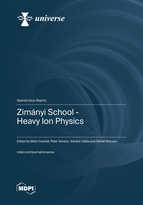Zimányi School – Heavy Ion Physics
A special issue of Universe (ISSN 2218-1997). This special issue belongs to the section "High Energy Nuclear and Particle Physics".
Deadline for manuscript submissions: closed (31 May 2023) | Viewed by 13623
Special Issue Editors
Interests: hydrodynamics in high-energy heavy ion physics; Bose–Einstein correlations; femtoscopy; forward (small-x) processes in particle physics
Special Issues, Collections and Topics in MDPI journals
Interests: heavy-ion physics
2. MATE Institute of Technology KRC, Gyöngyös, Hungary
Interests: high energy heavy ion collisions; relativistic hydrodynamics
Special Issue Information
Dear Colleagues,
We invite contributions from the 22nd Zimányi School Winter Workshop for inclusion in this Special Issue, aiming to summarize the developments of 2022 in high-energy heavy ion physics, paying particular attention to the new data emerging from the Relativistic Heavy Ion Collider (RHIC) and the Large Hadron Collider (LHC), SPS and J-PARC. This Special Issue is also open to results from other high-energy nuclear and particle physics facilities around the world, most importantly low-energy colliders, exploring the nuclear phase diagram (paying special attention to FAIR and NICA). Another aim of the Special Issue is to discuss important new results in hydrodynamics, flow and femtoscopy. One of our primary objectives is to encourage interaction between the theoretical and experimental community. Hence, we encourage contributions with this in mind. A slightly overlapping and not fully exclusive list of topics of includes (in alphabetical order):
- Effective QCD theory/model approaches
- Elastic scattering and diffraction (experiment+theory)
- Femtoscopy (experiment+theory)
- Flow and hydrodynamics (experiment+theory)
- Gluon saturation and electron-ion collider (experiment+theory)
- Heavy flavor and quarkonia (experiment+theory)
- Intermediate energies (FAIR, J-PARC, nuclear physics)
- Jets and high pT probes (experiment+theory)
- Magnetic field in heavy ion collisions (experiment+theory)
- Photons and dileptons (experiment+theory)
- QCD at non-zero temperature and density
- Search for the QCD critical point (experiment+theory)
- Strongly coupled gauge theories (beyond SM, AdS/CFT)
- Vorticity and polarization in heavy ion physics (experiment+theory)
Prof. Dr. Máté Csanád
Dr. Péter Kovács
Dr. Sándor Lökös
Dr. Dániel Kincses
Guest Editors
Manuscript Submission Information
Manuscripts should be submitted online at www.mdpi.com by registering and logging in to this website. Once you are registered, click here to go to the submission form. Manuscripts can be submitted until the deadline. All submissions that pass pre-check are peer-reviewed. Accepted papers will be published continuously in the journal (as soon as accepted) and will be listed together on the special issue website. Research articles, review articles as well as short communications are invited. For planned papers, a title and short abstract (about 100 words) can be sent to the Editorial Office for announcement on this website.
Submitted manuscripts should not have been published previously, nor be under consideration for publication elsewhere (except conference proceedings papers). All manuscripts are thoroughly refereed through a single-blind peer-review process. A guide for authors and other relevant information for submission of manuscripts is available on the Instructions for Authors page. Universe is an international peer-reviewed open access monthly journal published by MDPI.
Please visit the Instructions for Authors page before submitting a manuscript. Submitted papers should be well formatted and use good English. Authors may use MDPI's English editing service prior to publication or during author revisions.









